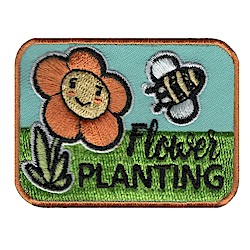.
This patch and all program supplies are available from our partner site MakingFriends®.com.
Download this coloring page about honey bees for younger achievers.
Use it as an optional requirement for young children to do before the meeting begins.
—————————————-
Requirement 1: Learn It!
Bees are an important part of the earth’s balance. They are pollinators. Bees gather pollen from flowers to stock their nests as food for their young. When bees fly from flower to flower they transfer pollen from flower to flower. This allows the plants to reproduce, making more plants. Flowers turn into things that people and other animals eat like nuts, fruits and vegetables. We also get cotton for our clothes, flavorings like vanilla, scents like lavender, beeswax for candles and don’t forget honey to sweeten our food!
But the bee population is declining. Scientists believe it is a combination of pesticides, parasites and infections. They also believe that noise and pollution may play a role.
Watch this video to find out more about how bees help the earth and why they are in need of help.
—————————————-
Requirement 2: See It!
Visit a Local Beekeeper
A beekeeper is someone who takes care of bees. They may also provide hives, food and medicine.
Some people keep bees as a hobby and some people earn money with their bees. Beekeepers harvest the hives to get honey and wax. Sometimes farmers keep bees to help pollinate their crops.
Find a beekeeper to visit. Bee Culture online magazine has links to beekeepers in the United States. An online search will also identify beekeepers in your area. You can also choose to visit a virtual beekeeper by watching this video.
Things to Find Out:
- What kind of plants do honey bees like? Helpful link: Pollinator-Friendly Plant Lists
- What plants will grow well in our area that honey bees like? Native Plants for Native Bees
—————————————-
Requirement 3: Do It!
You can help honey bees and other pollinators like butterflies and moths by planting flowers.
Participate in a honey bee gardening project. Here are some ideas:
- Participate in an organized honey bee garden planting.
- Improve or clean up a garden for honey bees.
- Plant a bee garden in your neighborhood.
- Make a container bee garden for your home.
It’s time to do your planting. Make sure you are prepared to be outside. Wear sun screen and a hat. Make sure to protect your arms and legs by wearing long sleeves and sturdy shoes or boots are a must.
If you see a bee while you are gardening, don’t be afraid. Bees don’t sting unless they feel threatened so don’t swat at them. Just continue with your job and they will continue with theirs. Watch this quick video to learn more.
—————————————-
Requirement 4: Review It!
Download the optional review sheet for younger achievers.
Discussion Points:
- Do you consider your honey bee garden a success?
- Would you do it again?
- What would you do different next time?
Why do you think honey bees are threatened?
- Do they have enough food?
- Do they have enough water?
- Are they getting sick?
Congratulations you have earned the Honey Bee Gardening patch! The patch can be purchased from our partner site MakingFriends®.com.
Does this give you some ideas for earning the Honey Bee Supporter Patch Program®?
See all our current Friend level Patch Program®s:
Environmental
Reduce Reuse
Recycle
Shore Clean Up
Gardening
Clean Up
Related Fun Patch Ideas:
Note: Many of the links provided to assist with completing our Patch Program®s are external and do not imply an endorsement or recommendation. At the time of publication, external content was vetted to the best of our ability. Your views and ideas may vary and we do not intend for you to substitute our opinions for yours. Research the topic thoroughly before beginning a project. As always, make sure children access the internet only under safe-surfing conditions.
©2019 youthsquad.makingfriends.com


















